In early February 2006, we spent 10 days in the West African country of Mali. Every day was interesting and some of the sights were the equal of those we have seen anywhere. Until the point in time that Mali first attracted our attention, we knew as little about it and about West Africa as most Americans, i.e., practically nothing. For this reason, when telling friends about our plans, we said we were going to the West African country of Mali. This provided at least a vague point of reference.
However,
identifying our destination as West Africa was probably of minimal help. Few
if any countries in this vast region, approximately the size of the continental
United States, are familiar to most Americans, nor were they to us until we
began developing our plans. How many could name West Africa as the location
of the nations of Togo, Gineau Bissau, Benin, Chad, The Gambia or Sierra Leone?
Who could identify the home countries for these capitals: Ouagadougou, Accra,
Abidjan, Banjul, Freetown, Nouakchott and Bamako?
On the basis of traveler's reports and the relatively sparse travel information
available on Mali, we concluded that we did not want to travel in Mali on
our own. There is virtually no infrastructure for independent tourism and
public transportation is only for the masochist. We
did not want to travel in this manner.
Moreover,
many areas of interest are reachable only by 4-wheel vehicles, and guides
are a virtual must in traditional areas. So we corresponded with several travel
companies and eventually decided to go with Saga Tours, based in Mali. It
turned out to be a great choice.
Most tours are "private"; i.e., you work with an agency to develop
an itinerary that is then implemented with a guide, driver, and vehicle. We
were following that plan when a new option surfaced. Saga Tours announced
a rare group tour, centered around a cultural festival. We liked the idea
of traveling with others and the group plan also reduced the costs. We signed
on.
About
Mali
Mali (formerly French Sudan) is a land-locked West African country about twice
the size of Texas with a population of about 12.5 million.
Demographics
Mali is a very poor country with a high infant mortality rate (116 deaths
per 1000 births), a very low life expectancy (48.64 years) and a low literacy
rate (46%). To give the infant mortality rate a human face: Mali's most famous
musician (Ali Farka Toure) was his mother's 10th child but the first to survive
beyond infancy. The fertility rate is 6.5 children per woman. About 80% of
the population is engaged in farming and fishing.
Politics
After some 70 years as part of French West Africa under colonial rule, Mali
became an independent country in 1960. It was governed by dictators until
1992 when a democratic presidential election was held. At this time, Mali
became the world's first democratic Muslim majority country. French is the
official language but the predominant language appeared to be Bambara, one
of at least 30 African languages spoken in Mali.
Topography
The Sahara Desert stretches across Mali's northern section, covering about
40% of the country's land mass. The Sahel, a semi-arid savanna (grasslands)
region, extends across the midsection of the country south of the Sahara,
covering another 20% of so of the nation's territory. This region is under
continual threat of desertification due to natural phenomena including drought
as well as human-generated causes such as deforestation and overpopulation.
The remaining 40% in the south of Mali receives more rainfall and is more
fertile, permitting some farming. This region also benefits from the inland
delta conditions caused by the annual flooding of the Niger River. But most
of Mali is dry and dusty, with temperatures ranging from hot to very hot all
year long. The most notable bird native to Mali is the Fire Finch, a name
that offers some hints about the climate.
Soccer
Sorcery
During the 2002 African Nations Cup tournament, Cameroon had a game scheduled
against Mali in Bamako. Cameroon's request for practice time at the Bamako
stadium on the day before the game was denied to prevent Cameroon's witch
doctors from casting a spell on the field. Ninety minutes before the start
of the game the next day, the Cameroon goalkeeper walked to the edge of the
field and dropped something. According to news accounts, riot police converged
on the keeper, handcuffed him and drug him away. He was released prior to
the game as Cameroon refused to play without him. A few weeks later, the African
soccer federation ruled that the keeper had violated the ban on witchcraft
and suspended him for one year for "outrageous and provocative"
behavior. Two months later, the ban was lifted when it was learned that the
keeper had been sprinkling lemon peels on the field to neutralize a spell
that had been cast by Malian witch doctors.
How could you not like a country where events of this nature are the major news of the week?
This
soccer sorcery information is based on stories published in the San Diego
Union Tribune by Mark Zeigler and in the Guardian in England.
Our Impressions of Mali
People
Seldom do you see anyone who appears in a hurry in Mali. Everyone seems to
be on "Mali time" which seems similar to Tony Hillerman's description
of Navajo time, a relaxed time frame in which showing up for a meeting within
a few hours of an agreed-upon meeting hour is considered punctual. In one
instance in Mopti our guide was arranging an excursion for us on the Niger.
The captain said he would be ready to leave in 20 minutes. Larry asked whether
that was 20 minutes Mali time. He laughed and replied that it was. Sure enough,
about 45 minutes later, we were on our way. We found this casual view of schedules
quite agreeable. Mali is definitely not a Type A country.
The people of Mali take great pride in their appearance and dress very colorfully and very neatly. Many plait their hair in interesting and ingenuous ways. They are, moreover, a handsome people. At the Festival on the Niger in Segou, everyone seemed to have made an extra effort to look their best.
Everywhere we traveled in Mali, we saw women and sometimes men gracefully carrying all manner of items (e.g., fruit, water, pottery, blankets, wood, baskets of fish) on their heads.
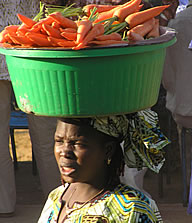
Malians are friendly and most seem to be easy going but at the same time high-spirited. And there is a tradition in West Africa of lively discourse about everyday affairs. So it is common to see people engaged in what might be misinterpreted as a rather heated debate that is, rather, a good natured form of amusement. Ross Velton, the author of the only English language guide to Mali that we know of, conveys obvious affection for Malians in describing the country as "one of the world's richest countries in human terms."
The
Niger River
The Niger, the third largest river in Africa, is a beautiful, tranquil sight
wherever you see it. Not surprisingly, it fronts many of the principal Malian
towns -- even Timbuktu. Well, it comes within 6 miles anyway. At that point,
the river takes one look at the Sahara ahead, says "no thanks" and
veers to the east toward Gao. The river is used for bathing and for cleaning
just about everything from dishes and clothes to cars and animals. The river
is, of course, also a means of transporting people, livestock and commercial
goods. And
perhaps most importantly, the river is a source of sustenance.
Roads
The national highway from Bamako to Mopti, a stretch of almost 400 miles,
is paved. Traffic is light but drivers must continually be on the alert for
slow-moving carts pulled by burros.
On the national highway, you pass small mud villages every 15 or 20 minutes. As we drove past these settlements, we could not stop taking pictures. There is always a line of ramshackle roadside stands at these points and the hustle and bustle is fascinating to watch. You see people, animals and wagons piled high with goods everywhere.
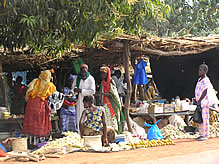
Roadside
Market
Virtually
every other road in the country is dirt, rock, or some bumpy combination.
All require sturdy 4-wheel drive vehicles. And in fact, the most common vehicle
in Mali is the rugged Toyota Land Cruiser. You see a smattering of SUVs and
even fewer traditional passenger cars. Plus, of course, large lumbering trucks,
buses, minibuses and motorbikes. Buses always seem to have goods and luggage
piled perilously high on top.
We were mostly in the semi-arid Sahel, an area of relatively sparse vegetation
reminiscent of the American southwest and often just as scenic.
Weather
In the lower two-thirds of the country (the portion south of the Sahara),
average highs range from the mid 80s to over 100°. Lows range from the
low 60s to the high 70s. The coolest months are November through February.
In the desert, of course, temperatures are more extreme in both directions.
During our February trip, highs were generally in the upper 90s and lows were
in the low 70s. Conditions were usually quite pleasant until about 10 am and
again after 4 pm. Between about 11 am and 3 pm, people tend to lay low. Even
during those hours, there was usually a slight breeze and, if you were in
the shade, the conditions were quite tolerable. When possible we did our driving
during these hours.
Cotton
Mali is the second leading exporter of cotton in Africa…right behind
Egypt.

Cotton Weaver
Bamako
The most reliable air route to Mali is on Air France from Paris to the capital
Bamako.
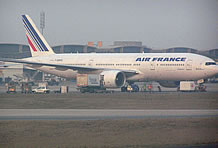
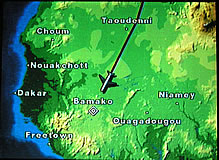
Flying Air France was a pleasure. Taoudenni is the location of the legendary Sahara salt mines.
Like many capitals, Bamako is a transitional stop you make only out of necessity. We arrived after dark so we didn't really see much of the city until the next day. But we saw enough to confirm what others say -- i.e., there's no reason to linger here.
Our very pleasant hotel (the Mande) was nicely situated on the Niger, some distance from the smoggy, dilapidated core of the city.
You don't have to stray very far from the Mande to see the real Bamako. Like all towns we visited, all of the streets (with the possible exception of the highway through town) are dirt.
And everywhere, there are people, 4-wheel drive vehicles, trucks, motorbikes, bicycles, push carts, carts pulled by burros, and goats, chickens, and cattle crossing the road. The pulse of daily life spreads out in all direction in a controlled sort of chaos.
Along
side the streets are open stands built of sticks with thatched roofs where
vegetables and just about everything else necessary for living can be purchased.
Segou
Segou is about 2 hours north of Bamako on the main highway. As you enter the town, you drive under a stand of leafy green trees. This rather grand entrance is about the only green you see until you make your exit.
Segou is not really a tourist town but provided a nice riverside setting for the Festival on the Niger. For us the festival was not a major reason for coming to Mali, just a component of the tour. Mali is famous for its music and many well known musicians participated. The Festival schedule also included parades, dancers, puppets, boat races, and arts and crafts.
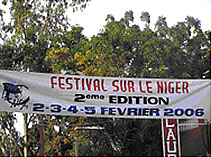
Old
Segou
One morning we drove 6 miles to Segoukoro (Old Seqou), a centuries-old intact
mud brick village along the Niger. The village is set some distance off the
main road from Segou to Bamako so the only access is by foot, donkey, burro
cart, motorbike or boat. Village scenes are amazing.
Old
Segou was founded in the early 1700s by the reigning monarch of the Bambara
Kingdom, one of the last of a long series of West African empires. This kingdom
ruled until the ascendancy of the French in 1890.
The village seemed lost in time, with people going about their daily activities
much as they did hundreds of years ago.
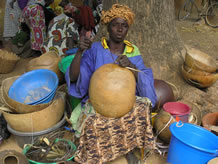
Mending
Cracked Calabashes
Old Segou was one of the picturesque highlights of our trip to Mali.
The
Bozo fishing and pottery village of Kalabougou
This village is across the river from Segou about an hour downstream via motorized
pirogue. At one point we waited for a herd of cattle to cross the river before
continuing on our way. We ceded the right of way. In the village, the men
are in charge of fishing while the women make pottery--lots of pottery.
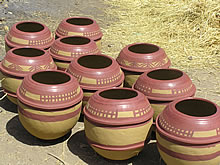
Handmade Pottery
It
is hard to believe that such places like Old Segou still exist, i.e., a mud
brick village where peoples' lives are little changed from centuries ago.
Djenne
Djenne was at one time in Timbuktu's class as an important trans-Saharan trade
site and a seat of Islamic scholarship. But that was many centuries ago. The
entire town of Djenne is now a UNESCO World Heritage Site and new buildings
must strictly comply with its classic Sudanese style of mud brick architecture.
The main attraction in Djenne is the great mosque, which can legitimately claim to be the world's largest mud brick structure. This beautiful structure gets a new coat of mud every spring. It has become a festival with groups in the community pitching in.
On Mondays, a colorful local market takes place in front of the mosque, spreading into nearby streets and alleyways.
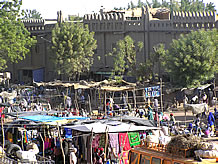
Djenne
Monday Market
Mopti
Mopti is invariably described as the most tourist-aggressive town in Mali
(with Djenne coming in second). While the hotel touts and would-be-guides
do their best to maintain that reputation, anyone who has been to, say, Egypt
or Morocco should not be bothered or intimidated in the slightest. Of course
having our own guide helped keep the touts at bay, but even when we were without
our guide it was not that bad.
Mopti is also described as the liveliest town in Mali and we would definitely agree with that. For centuries, Mopti has been Mali's most important port and the place fairly hums.
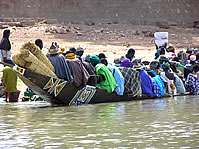
Mopti
Ferry
Blacksmiths are very important in every village. They handcraft everything made of metal from nails to tools to guns!
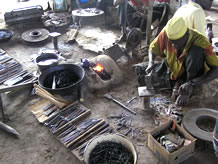
Balcksmith
Making Nails
Dogon
Country
The Dogon live in a series of more than 700 highly picturesque villages positioned
along the 125 mile-long Bandiagara escarpment 5 or 6 hours northwest of the
capital city. The rock formations along the escarpment resemble the canyon
lands area of Utah.
It is believed that the Dogon people arrived at the Bandiagara Escarpment around 1300-1400. The history of these people is by word of mouth so everything is approximate. The escarpment was already inhabited by the Tellem people. In Dogon lore, the Tellem had the ability to fly.
The Dogon continued to occupy the cliffs until the French occupation in 1890 stabilized the region, making it possible for them to move onto the plains below. These peaceful people, who number more than 300,000, are known for their animistic beliefs and their colorful crafts (especially woodcarving).
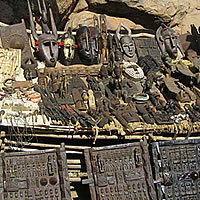
Dogon
Carvings for Sale
As we learned more about Dogon culture, this region became the primary focus for our trip to Mali. We spent 2 days in this area, trekking to villages by ascending and descending the escarpment. There are few paths; rather we climbed up and down the rocky terrain, sometimes aided by Dogon style ladders and rudimentary bridges made mostly of piles of rock. We would not be surprised if the Dogon language had only two directional words -- up and down - or perhaps many different words describing various nuances of up and down.
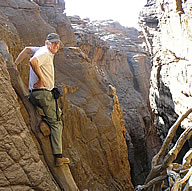
Larry
Ascends the Escarpment
on a Dogon Ladder
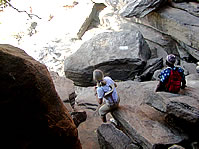
Judi
and Sori Descend
the Escarpment
The features that define a Dogon village combine to produce scenes that are incredibly picturesque. First, there are the granaries with conical, thatch roofs sprinkled among the traditional flat-topped mud brick dwellings.
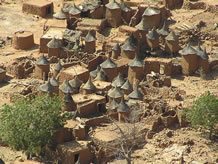
Dogon Granaries with
Conical Roofs
There are intricately carved wooded doors and window shutters on most dwellings.
The terrain is extremely rocky and residents use this natural building material to construct borders around property and along pathways adding further visual appeal. Then you have the villagers attired in their distinctive indigo fabrics and conical hats. Add to that various sacred fetishes positioned around the village. Then there is the jaw-dropping backdrop of the Bandiagara escarpment with the ancient Tellem cliff dwellings and tombs.
Finally, at some villages, the granite formations topping the escarpment add national park-like vistas. It is this combination of features that led us to rank the total visual effect at these villages as equal to the most impressive sights we have seen anywhere in our travels.
The
Dogon belief system is complex and compelling. Their cosmology is strongly
animistic, attributing powers to both plants and animals. The Dogon consequently
have great respect for the natural world. To cite just one example, the fox
is believed to have the ability to predict the future. When a person has a
question they would like answered, they visit one of the village "diviners."
There is a designated location outside the village with box designs outlined
in the dirt. The diviner creates appropriate symbolic marks in these plots,
places small sticks in selected locations, and scatters peanuts about the
design. During the night a fox will come and eat the peanuts, leaving a telling
trail. In the early morning, the diviner interprets the fox's foot prints
across the design to derive answers to the villager's questions and to make
predictions.
Due in part to the rugged terrain, interaction among villages is limited,
a circumstance that has created great variety in the beliefs and customs of
the many Dogon peoples. Though their culture is being penetrated and influenced
more and more by outside groups, the Dogon remain one of the most intact and
insulated groups in West Africa. A number of villages have been designated
as "traditional" and strictly adhere to Dogon customs. We visited
2 such villages. And there are a few remote villages where outsiders are excluded
to closely preserve traditions.
The Dogon are also known for their cultural performances, particularly their masked dances. We were fortunate to see the Dance of the Masks in Tireli. The masks, as the dancers are called, belong to a secret men's society and women are not allowed near them. The most difficult dances, requiring great skill, are performed on stilts by dancers dressed as a woman on top and a long legged water bird (tingetange) on the bottom and by the tiu (or tree) dancers with a huge mask from 6 to 18 feet high. There are dances for many different occasions. Ancestor worship is central to Dogon beliefs, making the funeral dance -- the final step in helping the soul of the departed to leave the village -- a very important event in the life of the village. The most important dance, the Sigi (when traditions are passed down), is held once every 60 years!
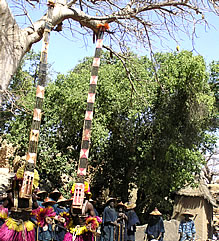
Tiu
(tree of life) Mask
Kola
Nuts
Kola nuts have long been valued throughout West Africa . They were one of
the prized commodities traded for salt when the camel caravans from Taoudenni
began arriving in Timbuktu nearly a millenium ago.
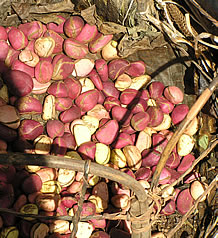
Kola
Nuts
Kola nuts are actually the seed pods of a type of tree found in West and Central Africa.. These colorful nuts, which are chewed, contain caffeine and have a bitter taste. The wide range of benefits attributed to kola nuts is quite similar to those claimed for chewing coca leaves in South America (particularly Bolivia and Peru). Kola nuts are widely believed to not only act as a stimulant and an anti-depressant, but (like coca leaves) to reduce fatigue and hunger, aid digestion, and even serve as an aphrodisiac. One suspects that kola nuts would also be credited with the ability to combat altitude sickness if West Africa happened to be 10,000 feet or so above sea level. Kola nuts were reportedly originally an ingredient Coca Cola and the basis for its name.
When trekking in Dogon country, it is a virtual neccesity to bring along a supply of these nuts as they will be expected as payment or gifts for taking pictures or for simply entering the village. On the advice of our guide Sory, we purchased a kilo (2.2 lbs.) in the Djenne market. Sory carried them and distributed them in appropriate quantities at appropriate times in the various Dogon villages we visited.
In preparation for this trip, we read an excellent book about the Dogon, Dogon : Africa's People of the Cliffs by Walter E.A. Vanbeek, 2001. The book focused on Tireli village and we were pleased when we learned that Tireli was one of the villages on our agenda. Upon our arrival we were greeted by Dogolu, the chief of the village.
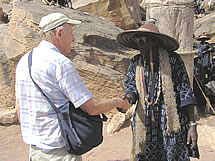
Dogon
Village Chief Greets Larry
We explained we had learned many facts about life in the village from our book. Later, while we were sitting in a shady area, the chief produced a copy of the book and proceeded to page through it, commenting on many of the people shown in it.
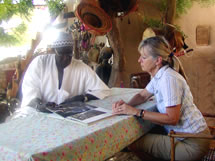
Judi
Looks Through
the Dogon Book
Greetings are important throughout Africa and one of the most charming features of Dogon life is their greeting ceremony. When a villager encounters another Dogon, a ceremony begins in which the older of the two first says hello and then asks a series of "how are" questions beginning with "How are you" and continuing with how is your family, wife, children, house, and then on to animals, fields and so on. Each query is replied to with "seo" (fine). Then the process is reversed. The whole ceremony has an appealing lyrical quality.
One additional note: The Dogon week has 5 days. We're not quite sure how that works out but a pretty attractive option would be to forget Mondays and Tuesdays; i.e., you have Wednesday through Friday and then the weekend. We could go for that.
Onions
In the 1930s, the French suggested that onions should do well in the Dogon
region. They were correct and onions became the most important crop exported
by the Dogon. Watering is a real challenge. Water is generally hand carried
to the fields in calabash gourds, often from some distance away. After harvesting,
the onions are dried, rolled into balls and shipped to other West African
countries where they are used as an ingredient in sauces and soups.
Timbuktu
Ah…Timbuktu. This place of near mythic status is what first attracted
us to Mali. Positioned on the very edge of the Sahara, Timbuktu signifies
remoteness. As our plans developed, ironically, it became clear that we were
not going to make it to Timbuktu on this trip. The legendary outpost was living
up to its reputation as a hard to reach place. We (particularly Larry) consoled
ourselves by remembering that the town is now only a sad remnant of its former
glory and, in the estimation of most visitors, of debatable interest. Nonetheless,
we wished we could have seen it. Maybe on our next trip to Mali.
Hotels
The Hotel Mande in Bamako was, as mentioned, quite nice. It was in Segou that
we got our first dose of reality. We had anticipated staying at the Hotel
Esplanade but it had apparently been booked many months in advance (or appropriated
by festival officials). The same was true of the other two preferred hotels
and we ended up at the Duonanke. It was definitely not a preferred hotel.
It was here that we first developed our list of Mali hotel guidelines, a list
we perfected as our experience expanded. There are a number of amenities you
look for in a hotel in Mali: a top sheet or blanket, hot water, a pillow bigger
than a postage stamp, more than one towel (though you may have little use
for them), a fully functional toilet, more than two hangers, more than one
electrical outlet (for recharging camera batteries), a window with screens,
a fan or air conditioner. In Mali, you consider yourself lucky if you have
at least three of these. You are even luckier if your a/c does not overload
the circuit causing it to shut down. Ours did so on two of our nights in Segou.
You can count on a bar of soap and at least a tiny bit of toilet tissue. Don't
even think about shampoo.
Hotels in more remote areas had been described as quite basic. While "basic" is a reasonable description -- e.g., the floors were concrete -- we found each of these places to be quite comfortable and even rather charming. We stayed in accommodations that would fall into the basic category in Djenne and in Sanga in Dogon country. To our surprise, each had a quite modern and effective air conditioner as well as a ceiling fan.
Cuisine
Saga Tours mentions on its website that you do not come to Mali for the cuisine--and
that proved to be true. The food was OK to good but nothing special. Breakfast
was generally good French bread and coffee. For lunch or dinner, Capitaine
(a type of fresh water fish) is quite popular and very tasty. Pamplemousse
(French for grapefruit) bottled soda was very refreshing.
The Bradt guide offers this exchange: "Do you have any Malian specialties? Yes, rice." The staples for Malians are indeed rice, millet, and couscous. Various types of sauces and stews are popular. Capitaine and other freshwater fish are often available. Chicken and mutton are common meat dishes. Limited cooked vegetables and fruit (e.g., papaya and mango) round out the meal.
Millet beer, which is made by women, is popular in rural areas. It also plays a key role in Dogon villages.
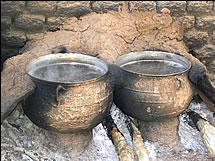
Brewing
Millet Beer
Two Important Trees
Baobab and shea trees are not cut down--they are too important, each in their own way.
Shea
Tree
The shea tree produces a nut that is processed locally to make shea butter,
used for cooking, skin care, and traditional medicine. Nuts from the shea
are exported as a substitute for cocoa butter and for pharmaceuticals. They
are also excellent shade trees.
Baobob
Tree
The baobab is a very distinctive looking, slow growing tree that can live
for thousands of years. The bark is stripped and made into rope; the fruit
is made into a beverage; the leaf is cooked like a vegetable and also ground
into a powder for sauces and stews; dried pods become rattles; and the fruit,
bark, and leaves are used for traditional medicine. It is a very handy tree
to have around.
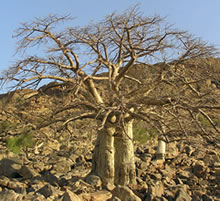
Baobob
Tree
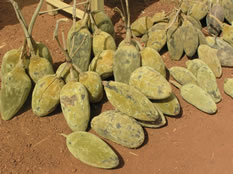
Baobob
Pods
Saga
Tours
Saga is a first class company www.sagatours.com.
The co-owner, Assou Sagara, has 30 years experience in the travel industry.
The company's web site is unusually informative and Assou was always prompt
and clear in his email replies to our questions. We were met upon arrival
at Bamako by our guide Sory, our driver Lassine, and by Assou, who eased our
way through immigration. All three accompanied us to the hotel and Assou returned
the next morning to provide us with a briefing. He called us in Segou to see
how the trip was progressing and kept in touch with Sory throughout our stay.
He returned to the hotel on our last morning to find out how everything had
gone, and met us again at the airport that evening to facilitate our departure
and see us off.
Saga Tours planned the trip as a group tour, anticipating about 12 participants. Though only 3 signed up, Assou honored the original price. Thus, the three of us had our own guide and driver, essentially a private tour at a group rate.
Sory is a very knowledgeable, and likable guide with an excellent command of English and Lassine is an unusually careful driver.
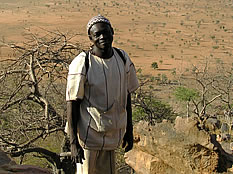
Our
Guide, Sory
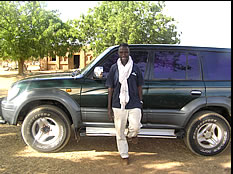
Our
Driver, Lassine
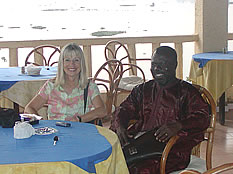
Judi
& Assou at Hotel Mande
Lassine, who has an appealing demeanor and was a pleasure to be around, speaks French but no English. Sory seemed to have friends in every village and was warmly welcomed everywhere. With Sory, we were able to visit several villages that rarely see tourists. In one or two instances, we encountered small children who were clearly afraid of the strange-looking visitors.
Our rugged Toyota Land Cruiser was well maintained and comfortable, with a powerful air conditioner that was most welcome during our travels in the hot afternoons.
As
we were planning this trip, we wrote a prelude describing our expectations.
Based on everything we had read, here's what we said we would be facing: intense
heat, suffocating air quality (in Bamako), forgettable food, rudimentary lodging,
high visa costs, unreliable travel schedules, dreadful roads, high malaria
risk, yellow fever certificate required, aggressive touts, extensive poverty,
locusts, and the effects of drought and famine. Anyone for Mali? Some of our
friends who read our prelude would certainly not have joined us even if they
could have done so for free. In fact, some who wondered whether we had taken
leave of our senses in planning trips to certain other far flung parts of
the world no longer retained any lingering doubts about out mental balance
upon reading about our plans. When we announced that we had committed to a
trip to Mali, some of these same friends suggested we should perhaps be committed.
In retrospect, though our description of the negatives in Mali proved to be
generally accurate, so did our account of the positives--as described and
depicted above. What lovely peoples and colorful cultures. We are already
planning our return.
Some of the material presented
in the kola nuts section is based on information contained in http://www.blackherbals.com/bissy.htm







